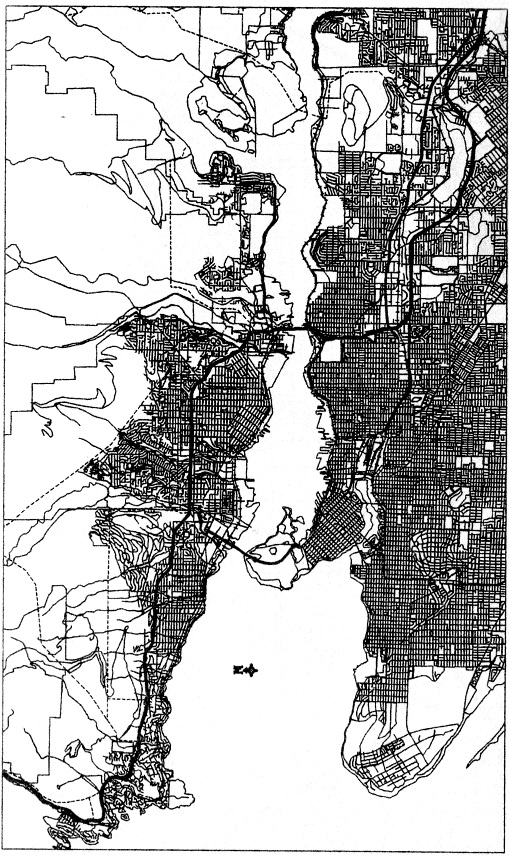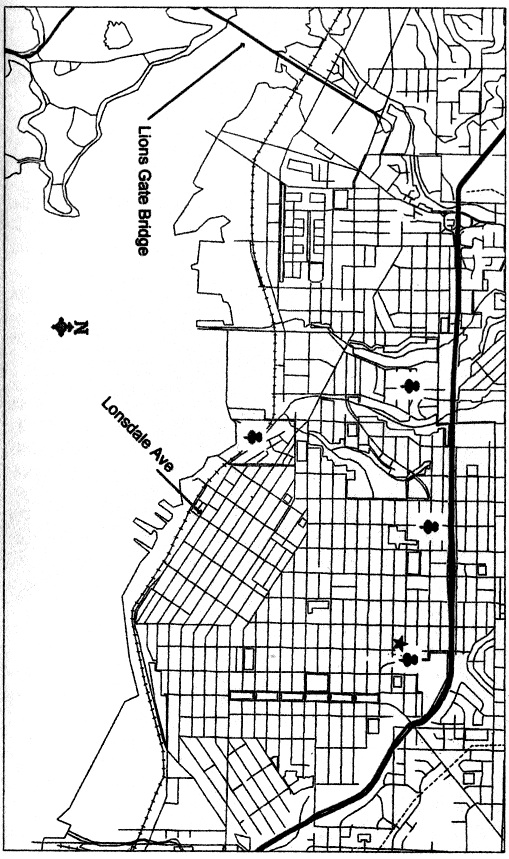Where, Not Why
Nick Craven's emotions swung back and forth like a pendulum: I love her, she loves me not, I love her, she loves me not. . . . Last night saw him maturely swallow the fact if Gill didn't love him, he couldn't change that, so Give me grace to accept the things I cannot change. This morning the moment he saw Gill sharing the coffee cup and laughing with DeClercq,, he flip-flopped back in resolve. But what right had he: to feel betrayed? If not for DeClercq in the Africa case, Nick would be serving life in prison for killing his mom. And if not for Gill in the same case, he would be food for fishes in Davy Jones's locker.
Why do fools fall in love? The lover's question, he thought.
Nick felt like a stalker.
Was that next?
From UBC, Nick drove to Headquarters and parked in the lot behind Special X. Trudging up Heather from Thirty-third to Thirty-seventh was a slip and slide. He entered the Operations Building, passed Security, and climbed to ViCLAS on the second floor.
Vancouver leads the world in geographic profiling. The Where, not the Why of hunting serial killers and sex offenders. Like most human activities, choosing a crime site has geographic logic. When you go to the store for a quart of milk, you don't bypass twenty stores to shop across town; you stop at the nearest one. What governs you is a quantifiable spatial rule as the least-effort principle. The same behavior governs crime, just as fear of arrest creates a buffer zone of predictable dimensions around a serial killer's home. Right-handed killers tend to flee to the left, but move to the right when they encounter obstacles. They discard evidence to the right, and hide near outside walls in buildings. A serial sex offender prefers a corner house which offers four, not two, escape routes.
And so on.
Each time a serial offender meets, attacks, kills, or dumps a victim, he leaves behind a point on a map. Except in the case of a transient killer with no roots, the crime site is linked by spatial behavior to anchor points like the killer's workplace or home. Since such behavior is governed by quantifiable rules, it can be analyzed by a computer. All the crime sites are plotted on a screen map. The computer draws a box around this "activity space" and divides it into a grid. Then using an equation based on criminology research into typical journeys to crime sites, the computer takes a beginning point on the grid and determines the distance from that point to the first crime site. The equation calculates the probability of that point being the bad guy's home, then repeats the process for all points on the grid and each crime site.
The result is a geographic profile of the activity space. Overlaying the street map of the city, it looks like a three-dimensional isopleth relief map like those used in school texts to show elevation or rainfall. The amoebas of the profile are different colors. Gray areas are least likely to be the bad guy's home. Hot spots in red predict the most probable home base of the serial offender.
His anchor point.
Nick was after nothing that elaborate today. Since he already knew where Bron Wren had lived twenty-five years ago, what he required was a map of the "activity space" generated by the six cases from four sites that had gone to court. The space would indicate where to look for other victims in the hair-fetish album. Album photos would be sent to all primary schools in the catch basin to match with past enrollment records. Once he had the names, he could hunt them down.
"All you want is a pin map?"
Rusty Lewis, the ViCLAS hotshot, was disappointed.
"Pins for the homes of his victims. And a star for Wren's basement suite."
Craven seated beside him at his office desk, Lewis booted up the ViCLAS computer and clicked the mouse on the Maplnfo icon. Opening a work space, he asked for a map of central Vancouver. The screen developed an image from seven overlaid maps: cosmetic layer or foundation; BCPLACES from the gazetteer; ADDRESS to pinpoint street locations; SWRIVER for creeks and shorelines; LMROAD to add highways and trains; municipal boundaries; and then attributes like Indian reserves.
Nick was glad this wasn't a Rorschach test.
Stanley Park and Point Grey looked like penises to him.
"You're looking down on the city from forty kilometers up," said Lewis.
"Zoom in on the North Shore from Lions Gate Bridge to Second Narrows."
"There," said Lewis. "Now you're looking down from four Ks up."
The image showed North Vancouver's shore along the inner harbor. Craven fed Lewis the addresses of victims in the court case twenty-five years ago, and where Wren had been living then. Lewis entered some location queries to add pins for the homes of the six victims and a star for Wren's anchor point. He labeled Lions Gate Bridge, Lonsdale Avenue (the main street with Nick's home), and inserted a compass.


"Why no buffer zone between the star and eastern pin?" said Nick.
"A pedophile is a driven man. Wren was overpowered by compulsion to molest the kids near his home even if it chanced arrest."
"I'll find them first."
"The ugly thing about sex crimes is how stigma and guilt attach to the victim. Sometimes the innocent will shed the name connected to what they see as their dirty self. Before you waste time chasing the shadow, I'd fax a request to Gazette records to check if the name was changed."
"I'll do that," said Nick.